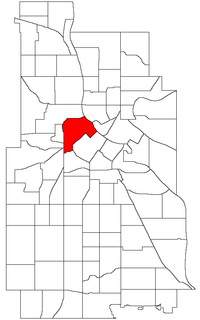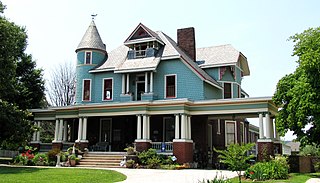
Waynesville is a town in and the county seat of Haywood County, North Carolina, United States. It is the largest town in Haywood County and the largest in western North Carolina west of Asheville. Waynesville is located about 30 miles (50 km) southwest of Asheville between the Great Smoky and Blue Ridge mountains.

The Avenues is a neighborhood in Salt Lake City, Utah. It is named after the perfectly gridlike, closely laid out roads called Avenues and Streets. First surveyed in the 1850s, the Avenues became Salt Lake City's first neighborhood. Today, the Avenues neighborhood is generally considered younger, more progressive, and somewhat "artsy" when compared to other neighborhoods. Many young professionals choose to live there due to the culture and easy commute to downtown.. It is also one of the most important strongholds of the Democratic political party in Utah.

The North Loop is a neighborhood of the Central community of Minneapolis, Minnesota. The neighborhood is commonly known as the Warehouse District from the city's shipping hub years. It includes the Minneapolis Warehouse Historic District which is listed on the National Register of Historic Places. The North Loop is located just northwest of the central business district between downtown Minneapolis and the Mississippi River. Streets in the North Loop are oriented to be parallel to the river, which means that they run at a 45-degree angle relative to the grid of the rest of the city.

The Wholesale District or Warehouse District in Downtown Los Angeles, California, has no exact boundaries, but at present it lies along the BNSF and Union Pacific Railroad lines, which run parallel with Alameda Street and the Los Angeles River. Except for some ancillary commercial uses, its cityscape is mostly occupied by warehouses and refrigerated storage facilities. This area is known as Central City North in the Los Angeles city zoning map.

Fletcher Place is a historic district and neighborhood in the city of Indianapolis, Indiana.

The Old City is a neighborhood in Knoxville, Tennessee, United States, located at the northeast corner of the city's downtown area. Originally part of a raucous and vice-ridden section of town known as "The Bowery," the Old City has since been revitalized through extensive redevelopment efforts carried out during the 1980s through the present. Currently, the Old City is an offbeat urban neighborhood, home to several unique restaurants, bars, clubs, and shops.
This is a list of the National Register of Historic Places listings in Knox County, Tennessee.

Feraud General Merchandise Store, also known as 1903 Building, was built in 1903 in Ventura, California. Jules Feraud opened the Feraud Bakery and Grocery Store and the bakery stayed in the family until 1944. The brick building is a rare intact example of turn-of-the-century commercial architecture during Second Land Boom after the tracks of the Southern Pacific Railroad arrived in Ventura. The City Council of Ventura designated the building Historic Landmark Number 35 by resolution on July 17, 1978. The building was listed on the National Register of Historic Places in 1986.

The Crescent Warehouse Historic District is a 10.5-acre (4.2 ha) historic district in Downtown Davenport, Iowa, United States. The district is a collection of multi-story brick structures that formerly housed warehouses and factories. Most of the buildings have been converted into loft apartments. The district was listed on the National Register of Historic Places in 2003.

Old North Knoxville is a neighborhood in Knoxville, Tennessee, United States, located just north of the city's downtown area. Initially established as the town of North Knoxville in 1889, the area was a prominent suburb for Knoxville's upper middle and professional classes until the 1950s. After a period of decline, preservationists began restoring many of the neighborhood's houses in the 1980s. In 1992, over 400 houses and secondary structures in the neighborhood were added to the National Register of Historic Places as the Old North Knoxville Historic District.

James Gilbert Sterchi was an American businessman, best known as the cofounder and head of the furniture wholesaler, Sterchi Brothers Furniture Company. At its height, Sterchi Brothers was the world's largest furniture store chain, with sixty-five stores across the southeastern United States and a worldwide customer base. In 1946, the company became the first Knoxville-based firm to be listed on the New York Stock Exchange. The company's ten-story headquarters, now called Sterchi Lofts, stands prominently along Knoxville's skyline, and Sterchi's home in northern Knoxville, Stratford Mansion, is listed on the National Register of Historic Places.

Gay Street is a street in Knoxville, Tennessee, United States, that traverses the heart of the city's downtown area. Since its development in the 1790s, Gay Street has served as the city's principal financial and commercial thoroughfare, and has played a primary role in the city's historical and cultural development. The street contains Knoxville's largest office buildings and oldest commercial structures. Several buildings on Gay Street have been listed on the National Register of Historic Places.

The National Building is a historic warehouse building in downtown Seattle, Washington, located on the east side of Western Avenue between Spring and Madison Streets in what was historically Seattle's commission district. It is now home to the Seattle Weekly. It is a six-story plus basement brick building that covers the entire half-block. The dark red brick facade is simply decorated with piers capped with small Ionic capitals and a small cornice, which is a reproduction of the original cornice. Kingsley & Anderson of Seattle were the architects.
Caldonia Fackler Johnson was an American businessman and philanthropist, active primarily in Knoxville, Tennessee, in the late 19th and early 20th centuries. Born into slavery, he rose to become a prominent Knoxville racetrack and saloon owner, and by the time of his death, was one of the wealthiest African-American businessmen in the state. He also owned several thoroughbred racehorses, one of which captured a world speed record in 1893.

The Baumann family was a family of American architects who practiced in Knoxville, Tennessee, and the surrounding region, in the late 19th and early 20th centuries. It included Joseph F. Baumann (1844–1920), his brother, Albert B. Baumann, Sr. (1861–1942), and Albert's son, Albert B. Baumann, Jr. (1897–1952). Buildings designed by the Baumanns include the Mall Building (1875), the Church of the Immaculate Conception (1886), Minvilla (1913), the Andrew Johnson Building (1930), and the Knoxville Post Office (1934).

The Auto Freight Transport Building of Oregon and Washington, also known as East Side Terminal and Eastbank Commerce Center, in southeast Portland in the U.S. state of Oregon is a four-story commercial structure listed on the National Register of Historic Places. Built in 1924, it was added to the register in 2005.

The Wynne Wholesale Commercial Historic District encompasses a small collection of historic commercial properties in Wynne, Arkansas. It extends for two blocks along West Merriman Avenue, west of Martin Luther King Jr. Boulevard, and includes four historic buildings: the Wynne Municipal Water Works, the Wynne Wholesale Grocer Company building, the R. J. Jackson Gin Company's cotton gin, and the Sharp Floral Building. A fifth building, the Wynne Ice & Coal Company's ice house, also stands in the district, but has been recently modified. These building are representative of wholesale business activities that took place in Wynne in the first half of the 20th century.

The Morris Avenue Historic District is an industrial district in Birmingham, Alabama. The district covers Morris Avenue from 20th Street to 25th Street and First Avenue from 21st to 26th Street. The Morris Avenue section comprises a set of late 19th century masonry warehouses that were Birmingham's main food distribution center until the 1950s. The First Avenue section of the district comprises a mixed neighborhood of late 19th century offices and warehouses, built shortly after the Morris Avenue development. The combined areas include 63 contributing structures, of the 69 buildings in the district. Notable buildings include the Liberty Trouser Building and the A.C. Legg Building on Morris Avenue on either side of the Moskowitz Warehouse. On First Avenue the Birmingham Realty Building and the A.A. Adams Realty Building, as well as the Goodall-Brown Building are notable.





















